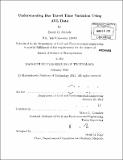| dc.contributor.advisor | Marta C. González. | en_US |
| dc.contributor.author | Gerstle, David G | en_US |
| dc.contributor.other | Massachusetts Institute of Technology. Dept. of Civil and Environmental Engineering. | en_US |
| dc.date.accessioned | 2012-05-15T21:10:29Z | |
| dc.date.available | 2012-05-15T21:10:29Z | |
| dc.date.copyright | 2012 | en_US |
| dc.date.issued | 2012 | en_US |
| dc.identifier.uri | http://hdl.handle.net/1721.1/70763 | |
| dc.description | Thesis (S.M. in Transportation)--Massachusetts Institute of Technology, Dept. of Civil and Environmental Engineering, 2012. | en_US |
| dc.description | Cataloged from PDF version of thesis. | en_US |
| dc.description | Includes bibliographical references (p. 89-94). | en_US |
| dc.description.abstract | The benefits of bus automatic vehicle location (AVL) data are well documented (see e.g., Furth et al. (2006)), ranging from passenger-facing applications that predict bus arrival times to service-provider-facing applications that monitor network performance and diagnose performance failures. However, most other researchers' analyses tend to use data that they acquired through negotiations with transit agencies, adding a variable cost of time both to the transit agencies and to researchers. Further, conventional wisdom is that simple vehicle location trajectories are not suitable for evaluating bus performance (Furth et al. 2006). In this research, I use data that are free and open to the public. This access enables researchers and the general public to explore bus position traces. The research objective of this Master's Thesis is to build a computational system that can robustly evaluate bus performance across a wide range of bus systems under the hypothesis that a comparative approach could be fruitful for both retrospective and real-time analysis. This research is possible because a large number of bus providers have made their bus position, or AVL, data openly available. This research thus demonstrates the value of open AVL data, brings understanding to the limits of AVL data, evaluates bus performance using open data, and presents novel techniques for understanding variations in bus travel time. Specifically, this thesis demonstrates research to make the system architecture robust and fruitful: " This thesis explores the exceptions in the various datasets to which the system must be robust. As academics and general public look to exploit these data, this research seeks to elucidate important considerations for and limitations of the data. " Bus data are high-dimensional; this research strives to make them dually digestible and informative when drawing conclusions across a long timescale. Thus, this research both lays the foundation for a broader research program and finds more visually striking and fundamentally valuable statistics for understanding variability in bus travel times. | en_US |
| dc.description.statementofresponsibility | by David G. Gerstle. | en_US |
| dc.format.extent | 94 p. | en_US |
| dc.language.iso | eng | en_US |
| dc.publisher | Massachusetts Institute of Technology | en_US |
| dc.rights | M.I.T. theses are protected by
copyright. They may be viewed from this source for any purpose, but
reproduction or distribution in any format is prohibited without written
permission. See provided URL for inquiries about permission. | en_US |
| dc.rights.uri | http://dspace.mit.edu/handle/1721.1/7582 | en_US |
| dc.subject | Civil and Environmental Engineering. | en_US |
| dc.title | Understanding bus travel time variation using AVL data | en_US |
| dc.type | Thesis | en_US |
| dc.description.degree | S.M.in Transportation | en_US |
| dc.contributor.department | Massachusetts Institute of Technology. Department of Civil and Environmental Engineering | |
| dc.identifier.oclc | 789664855 | en_US |
